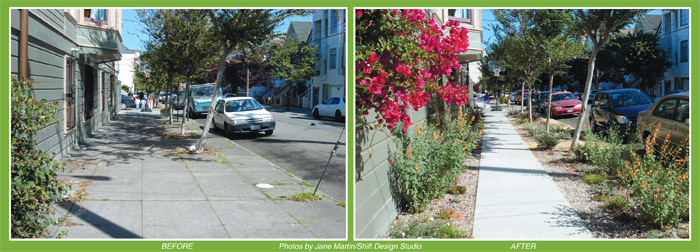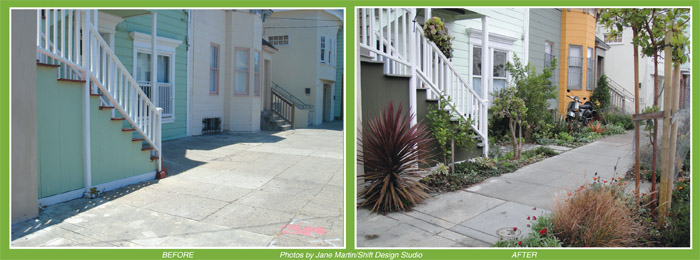It’s no secret that a garden can greatly improve a person’s quality of life and overall wellbeing.

According to PlantSF’s Jane Martin, the key to a successful, long-lasting sidewalk planting is choosing the appropriate, easy-to-care-for plants.
By Bill Picture
Published: February, 2010
It’s no secret that a garden can greatly improve a person’s quality of life and overall wellbeing. But space for a garden—even a modestly sized one—is hard to come by in San Francisco, where homes are typically built out to the edges of property lines. That’s one of the reasons that Jane Martin, founder of PlantSF, has been pushing to give the City’s sidewalks a makeover. She is spearheading an effort that trades in underutilized stretches of concrete for small, easily maintained plots that the entire neighborhood can enjoy.
“I think of it as creating some civility in an urban landscape,” Martin said. Martin’s crusade to literally green San Francisco’s sidewalks began in 2003, when, while renovating the home office from which she runs her architecture and landscape design firm, Shift Design Studio, she decided to also spruce up the wide sidewalk just outside her property.
“The sidewalks in my neighborhood are 14 feet wide and all concrete except for the odd tree here and there. It’s like that in a lot of neighborhoods,” she explained. “That’s a lot of sidewalk, and, a lot of times, it just becomes a parking lot because people pull their cars up on the sidewalk and park right there.”
Martin thought she could put the sidewalk to better use. In fact, she considered it her right because, technically, the sidewalk was hers to maintain. “Sidewalks are public property but privately maintained,” she said. “It’s the property owner’s responsibility to maintain the sidewalk. So, if it’s my responsibility, then why shouldn’t I have some say in what it looks like and how it’s used?”
Martin quickly discovered that there was no such thing as a sidewalk landscaping permit. Instead, such projects needed to adhere to city guidelines that regulate the use of sidewalk space for private use. Those guidelines included a hefty city fee, which Martin thought was unfair since her project (and others like it) would ultimately benefit the public.
When the San Francisco Neighborhood Parks Council began soliciting ideas from residents for the location of a new park in Martin’s neck of the Mission District, she proposed sidewalk plantings as an alternative to traditional parks in open-space-deficient neighborhoods like hers, where the City would have to buy the land to build a park.
“I said, ‘Instead of incurring the expense to build one of these destination parks, how about incorporating nature into our everyday lives?’”
Martin’s idea made her a few fans at City Hall. Still, she didn’t get the City’s full attention until she also offered up sidewalk plantings as a solution to the ongoing problem of sewer backups.
San Francisco is one of the few major cities still utilizing a single network of sewer pipes to collect and treat both wastewater and rainwater. While the combined system functions sufficiently under normal conditions, heavy rains overload it, resulting in backups that are less than pleasant. Martin theorized that removing concrete to expose soil that will absorb some of the rainwater would help reduce these backups.
When Mayor Gavin Newsom first took office and began looking for ways to stop the nasty sewer backups plaguing the southeast party of the City, Martin invited him to also come to the Mission. He accepted her invitation and, during that meeting, she explained her idea, outlined the benefits and proposed creating a permit specifically for sidewalk plantings.
“He loved the idea and basically told the Department of Public Works, ‘Listen to this lady. She’s onto something,’” Martin joked.
The result was a permit coauthored by Martin, the Department of Public Works’ Bureau of Street Use and Sewer Repair, and the Bureau of Urban Forestry. The wording took two years to get just right, but the Sidewalk Landscaping Permit was finalized and signed into law in June 2006. “Over 700 people have applied for permits so far, all without much exposure,” Martin said. “A lot of people still don’t know that the program exists.”
To promote sidewalk landscaping and other neighborhood enrichment projects, the City has created the Community Challenge Grants Program, which awards up to $100,000 to projects that engage residents and businesses to create green spaces, gathering places and public art.
Martin also makes herself available to residents who wish to engage a neighbor or a group of neighbors for the purpose of beautifying an entire block, as opposed to a single sidewalk planting in front of one home. Martin meets with the group to outline the benefits of sidewalk plantings, explain the process and discuss cost. Some property owners and groups have hired Shift Design Studio to do the work for them. But Martin insists that, with a minimal amount of research, property owners could undertake such a project entirely on their own. To encourage neighbors to work together, group discounts were included in the permit fee schedule.
On the PlantSF website, there’s also a “how-to” section that explains in detail how to go about the process, from drawing up plans and applying for permits to preparing the soil and doing the actual planting. Martin refers prospective planters with further technical questions to the San Francisco Parks Trust, PlantSF’s fiscal sponsor, and the Bureau of Urban Forestry.
“That probably undercuts my business, doesn’t it?” Martin said. “But I really believe that people should be able to do this on their own without having to hire a landscape designer.”
That said, Martin’s business has actually picked up. Her work on various sidewalk landscaping projects helped her nab a contract to do a ¾-mile planting along Cesar Chavez, and a commercial developer has hired her to make over an entire block of Stevenson Street, near the Powell Street BART station.
“Whenever I’m out and about and I see one of these projects, I get really excited,” she said, “because they really provide a significantly improved experience. Where once there was just concrete, now there’s something alive and growing. For toddlers, all of this action is right at eye level. For seniors and others with mobility issues, who can’t make it to the park, we’re bringing the park to them. It changes the way people look at their own neighborhoods.”
For more information on PlantSF, visit www.plantsf.org.

Wide sidewalks in many San Francisco neighborhoods, including the Mission District, allow for the creation of beautiful sidewalk plantings that beautify the neighborhood without interfering with pedestrian walkways.

Sidewalk landscaping can not only turn a gray stretch of city block into something living and beautiful, it can also help divert rainwater from the City’s easily overloaded sewer system.

